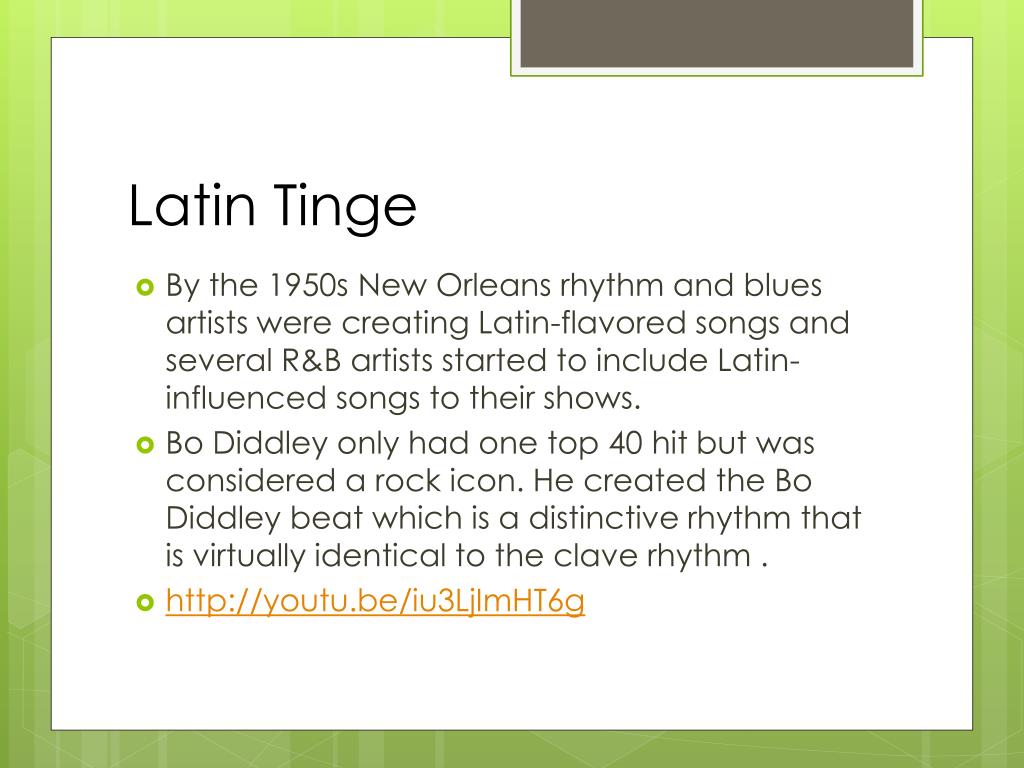

With the first edition of The Latin Tinge, John Storm Roberts offered revolutionary insight into the enormous importance of Latin influences in U.S. Latino rap has brought a musical revolution, while Latin and Brazilian jazz are ever more significant on the jazz scene. You can still hear it, but most people don't even know that expression.The Tejano superstar Selena and the tango revival both in the dance clubs and on Broadway are only the most obvious symptoms of how central Latin music is to American musical life. "It's Over" by Roy Orbison, Spanish Tinge. It's actually a musical category, like "Under the Boardwalk" is Spanish Tinge. You've certainly had a lot of straightforward, stripped-down songs over the years, but what's the arrangement process like for you now?" Waits: "Well, that song was an attempt at some of the – you know what they call it – Spanish Tinge. Q: "There's a song on the album that I like very much called "Back in the Crowd", and it's almost disarming in its simplicity. "Tom Waits: The one-of-a-kind singer-songwriter on his new LP, Bad as Me". Jelly Roll's autobiography, largely drawn from Jelly Roll Morton the Complete Library of Congress Recording. Jelly Roll: The Fortunes of Jelly Roll Morton, New Orleans Creole and "Inventor of Jazz" by Alan Lomax. Shown with tied sixteenth & eighth note rather than rest. Shown in common time and then in cut time with tied sixteenth & eighth note rather than rest. Struggling to Define a Nation: American Music and the Twentieth Century, p. Cubano Be Cubano Bop One Hundred Years of Jazz in Cuba.

^ Morton, “Jelly Roll” (1938: Library of Congress Recording) The Complete Recordings By Alan Lomax.Morton also called attention to the habanera in " Saint Louis Blues" as one of the elements in the song's success. "New Orleans Joys"), "La Paloma", "The Crave", and "The Spanish Tinge". Tunes with the "tinge" include "New Orleans Blues" (a.k.a. Morton categorized his compositions in three groups: blues, stomps, and Spanish tinge, for those with habanera rhythms. What is known in Latin music as the habanera rhythm is also known as the congo, tango-congo, and tango. Morton demonstrated the "tinge" to Alan Lomax in the 1938 Library of Congress recordings. What Morton called "Spanish" were the tresillo and habanera rhythms of the Cuban contradanza ("habanera"). In fact, if you can't manage to put tinges of Spanish in your tunes, you will never be able to get the right seasoning, I call it, for jazz. Now in one of my earliest tunes, "New Orleans Blues", you can notice the Spanish tinge. The difference comes in the right hand – in the syncopation, which gives it an entirely different color that really changes the color from red to blue. Now take the habanera " La Paloma", which I transformed in New Orleans style. I tried to play them in correct tempo, but I personally didn't believe they were perfected in the tempos. In his Library of Congress recordings, after referencing the influence of his own French Creole culture in his music, he noted the Spanish (read Cuban) presence: The phrase is a quotation from Jelly Roll Morton. The Spanish tinge is an Afro-Latin rhythmic touch that spices up the more conventional 4Ĥ rhythms commonly used in jazz and pop music.


 0 kommentar(er)
0 kommentar(er)
